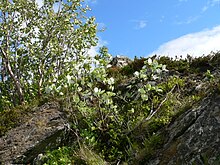
Sorbus is a genus of about 100–200 species of trees and shrubs in the rose family, Rosaceae. Species of Sorbus (s.l.) are commonly known as whitebeam, rowan, service tree, and mountain-ash. The exact number of species is disputed depending on the circumscription of the genus, and also due to the number of apomictic microspecies, which some treat as distinct species, but others group in a smaller number of variable species. Recent treatments treat Sorbus in a narrower sense to include only the pinnate leaved species of subgenus Sorbus, raising several of the other subgenera to generic rank.
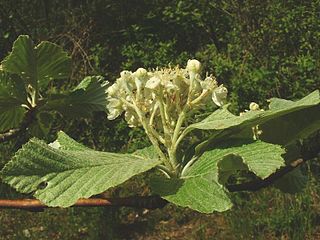
The whitebeams are members of the family Rosaceae, comprising subgenus Aria of genus Sorbus, and hybrids involving species of this subgenus and members of subgenera Sorbus, Torminaria and Chamaemespilus. They are deciduous trees with simple or lobed leaves, arranged alternately. They are related to the rowans, and many of the endemic restricted-range apomictic microspecies of whitebeam in Europe are thought to derive from hybrids between S. aria and the European rowan S. aucuparia; some are also thought to be hybrids with the wild service tree S. torminalis, notably the service tree of Fontainebleau Sorbus latifolia in French woodlands.

Sorbus torminalis, with common names wild service tree, chequers, and checker tree, is a species of tree in the mountain ash or rowan genus (Sorbus) of the rose family (Rosaceae), that is native to Europe, parts of northern Africa and western Asia.
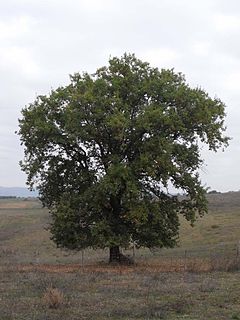
Quercus pubescens, the downy oak or pubescent oak, is a species of white oak native to southern Europe and southwest Asia, from northern Spain (Pyrenees) east to the Crimea and the Caucasus. It is also found in France and parts of central Europe.

Karpatiosorbus latifolia is a species of whitebeam that is endemic to the area around Fontainebleau, south of Paris in France, where it has been known since the early eighteenth century.
The Arran whitebeams are species of whitebeam endemic to the island of Arran, Ayrshire, Scotland.

Sorbus arranensis, sometimes referred to as the Scottish or Arran whitebeam is a species of plant in the family Rosaceae. It is endemic to the island of Arran in Scotland.

Sorbus eminens, the round-leaved whitebeam, sometimes classified as Aria eminens when the Aria subgenus of Sorbus is elevated to full genus, is a species of plant in the family Rosaceae. It is endemic to Great Britain. It is threatened by habitat loss.
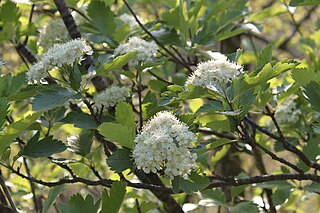
Sorbus leyana. Ley's whitebeam, is a species of small tree which is endemic to two sites in southern Wales. It is thought to have arisen by hybridisation of two species of Sorbus, one of which was the rowan. Its closest relatives are some of the other hybrid derived Sorbus species found in Britain.
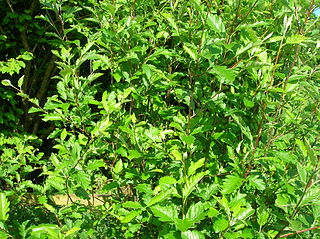
Sorbus pseudofennica is a species of plant in the family Rosaceae. Endemic to the Isle of Arran in Scotland, it is threatened by habitat loss. It is thought to be a naturally occurring hybrid between S. arranensis and S. aucuparia, probably with additional backcrossing with S. aucuparia. Sorbus arranensis is itself a hybrid between S. rupicola and S. aucuparia. Apomixis and hybridization are common in some groups of Sorbus species.
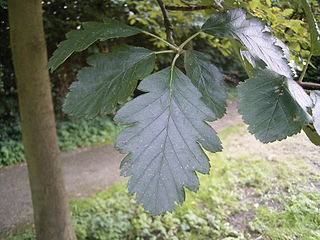
Sorbus intermedia, the Swedish whitebeam, is a species of whitebeam found in southern Sweden, with scattered occurrences in easternmost Denmark (Bornholm), the far southwest of Finland, Estonia, Latvia and northern Poland.

Sorbus × hybrida, the oakleaf mountain ash, Swedish service-tree or Finnish whitebeam, is a hybrid species of whitebeam native to Norway, eastern Sweden, southwestern Finland, and locally in Latvia.

Sorbus alnifolia, also called alder-leafed whitebeam, Korean whitebeam, or Korean mountain ash, Chinese: 水榆花楸; pinyin: shui yu hua qiu; lit. 'water elm rowan', is a species of whitebeam native to eastern Asia in eastern and northern China, Taiwan, Korea and Japan.
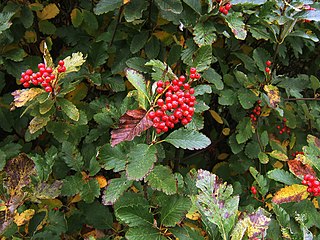
Sorbus mougeotii, the Vosges whitebeam or Mougeot's whitebeam, is a species of whitebeam native to the mountains of central and western Europe from the Pyrenees east through the Alps to Austria, and north to the Vosges Mountains.

Sorbus minima, commonly known as the lesser whitebeam or least whitebeam, is a shrub belonging to the subgenus Aria (whitebeams) in the genus Sorbus. It is endemic to Wales where it grows at a few sites in Breconshire. It is an apomictic microspecies which reproduces asexually and so is reproductively isolated from its close relatives such as the Swedish whitebeam, S. intermedia. It probably originated as a hybrid between the rock whitebeam and the rowan. It was first discovered in 1893 by Augustin Ley, the vicar of Sellack in Herefordshire who travelled widely in Wales.

Malinae is the name for the apple subtribe in the rose family, Rosaceae. This name is required by the International Code of Nomenclature for algae, fungi, and plants, which came into force in 2011 for any group at the subtribe rank that includes the genus Malus but not either of the genera Rosa or Amygdalus. The group includes a number of plants bearing commercially important fruits, such as apples and pears, while others are cultivated as ornamentals.
Karpatiosorbus houstoniae, or Houston's whitebeam, is a hybrid of two deciduous trees: the common whitebeam and the Bristol whitebeam. Only a single example of the hybrid is known to exist, at the Avon Gorge in Bristol, England. The only specimen grows on a cliff below Stokeleigh Camp at Leigh Woods in North Somerset and cannot be accessed without ropes.
Sorbus scannelliana, Scannell's whitebeam, is a species of whitebeam endemic to Ross Island near Killarney in southwest Ireland. It is one of the rarest tree species in the world; only five individual plants are known.
Sorbus leighensis, the Leigh Woods whitebeam, is a rare species of whitebeam, a flowering plant in the rose family.
